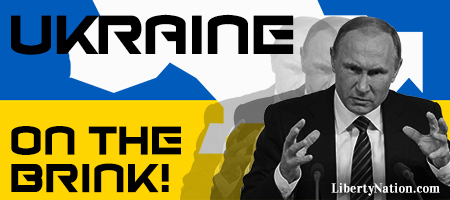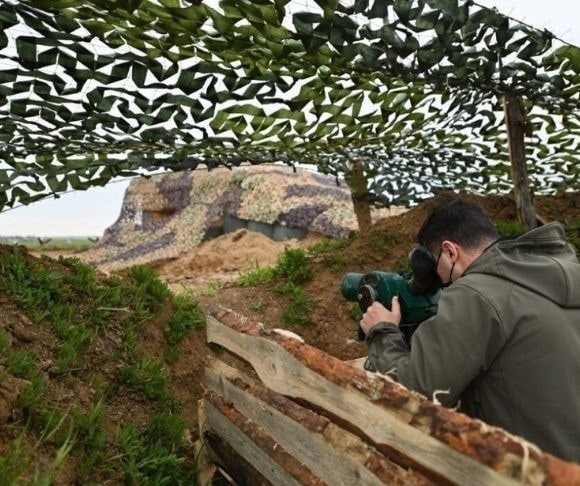Russian troops stationed on Ukraine’s border threatening an invasion have been a lingering crisis since the Spring of last year. Finally, in March 2021, the Kremlin provoked the rest of Europe and NATO to take notice of the escalating tensions. Observers on the ground in Ukraine spotted a Russian MI-8 military helicopter crossing the border. Later that same month, Russian combat forces fired mortars into the country, killing four Ukrainian soldiers.
 In response, NATO began a series of troop exercises called Defender Europe 2021, reputed to be one of NATO’s most extensive military exercises in decades, according to Army Times. Russia claimed the training escalated tensions and began “massing thousands of military personnel” on its western borders with Ukraine. But, as Liberty Nation reported, the build-up of troops was not only a threatening message to the Ukrainians but also a test of the three-month-old Biden administration’s resolve.
In response, NATO began a series of troop exercises called Defender Europe 2021, reputed to be one of NATO’s most extensive military exercises in decades, according to Army Times. Russia claimed the training escalated tensions and began “massing thousands of military personnel” on its western borders with Ukraine. But, as Liberty Nation reported, the build-up of troops was not only a threatening message to the Ukrainians but also a test of the three-month-old Biden administration’s resolve.
Not impressed with the response to what he could see was a menacing crisis building, Ukraine’s president Volodymyr Zelensky in April reached out to NATO’s secretary-general, Jens Stoltenberg, asking to expedite consideration of Ukraine’s membership in the alliance. LN characterized this outreach as a frantic call for help. The last position NATO took on Ukraine’s admission into the alliance was in 2008 at the Bucharest Summit. The consensus was “Georgia and Ukraine will become members of NATO in the future,” according to the NATO website.
When President Biden and Russia’s President Vladimir Putin met the following June for their first summit in Geneva, Switzerland, the discussions did not make progress on the crisis. At that point, there were around 70,000 Russian soldiers on the border. Not until a December 7, 2021, secure video call between presidents Biden and Putin did Ukraine take a leading role in U.S. diplomatic transactions with Russia. Though little was resolved during the call, National Security Advisor Jake Sullivan called the two leaders’ conversation useful. President Biden warned an invasion of Ukraine by Kremlin troops would be met with strong economic sanctions. Putin reiterated Moscow’s demands the U.S. and NATO ensure Ukraine would not gain membership in the alliance. Biden countered that Ukraine is a sovereign country and can join any organization it wishes.
 Roughly a week after the call, Moscow submitted its mandates for deescalating tensions on the Ukraine border. The new demands included banning U.S. and NATO from sending warships and aircraft to regions where they could strike Russia as well as halting NATO military drills near Russia. Putin once again emphasized he wanted guarantees Ukraine would not be part of NATO. So, Russia’s recommendations were nonstarters. Meanwhile, the Russian troop count on the border had increased to 120,000, as Military Times reported. At Putin’s request on December 30, he and President Biden had another phone conversation over the tense situation building in Europe over the threatening Russian military maneuvers on Ukraine’s easter border. As it turned out, the substance of the call was a rehash of the positions held by Russia and those held by NATO and the U.S.
Roughly a week after the call, Moscow submitted its mandates for deescalating tensions on the Ukraine border. The new demands included banning U.S. and NATO from sending warships and aircraft to regions where they could strike Russia as well as halting NATO military drills near Russia. Putin once again emphasized he wanted guarantees Ukraine would not be part of NATO. So, Russia’s recommendations were nonstarters. Meanwhile, the Russian troop count on the border had increased to 120,000, as Military Times reported. At Putin’s request on December 30, he and President Biden had another phone conversation over the tense situation building in Europe over the threatening Russian military maneuvers on Ukraine’s easter border. As it turned out, the substance of the call was a rehash of the positions held by Russia and those held by NATO and the U.S.
During the period January 10-13, intense negotiations involving the lead diplomats of the U.S., NATO, E.U., and Russia met at various venues. The result of the whirlwind round of talks was simply that the intransigence of both sides on the Ukraine border crisis was as strong as ever. In an unguarded moment, President Biden decided to opine in a press conference that Russia would invade Ukraine. His comment created chaos of confusion for Russia and U.S. allies alike. The result was a loss of U.S. credibility in dealing with the crisis.
As it stands, the U.S. and NATO have agreed to provide written responses to the Kremlin’s demands, which they did individually with two separate documents. However, Russian officials were not happy with what they got. “We cannot say that our thoughts have been taken into account or that a willingness has been shown to take our concerns into account,” Dmitry Peskov, Putin’s spokesman, complained. The number of Russian combat troops on Ukraine’s border is now 127,000.
According to Department of Defense spokesman John Kirby, U.S. combat forces on heightened alert number 8,500, including members of the 82nd Airborne Division and XVIII Airborne Corps at Fort Bragg, North Carolina. To emphasize the combat capability NATO could bring to a shooting conflict over a Russian invasion of Ukraine, U.S. Chairman of the Joint Chiefs of Staff Mark Milley said on January 28, in a televised statement, “NATO has significant military capability. NATO has approximately 130-plus brigades of maneuver forces, not including U.S. forces, 93 squadrons of high-end fighters, four carriers, many more surface combatants. The military capability of NATO is very, very significant.”
Liberty Nation will be updating its reporting under this banner as the crisis on the Ukraine border unfolds.
The views expressed are those of the author and not of any other affiliation.
~ Read more from Dave Patterson.




